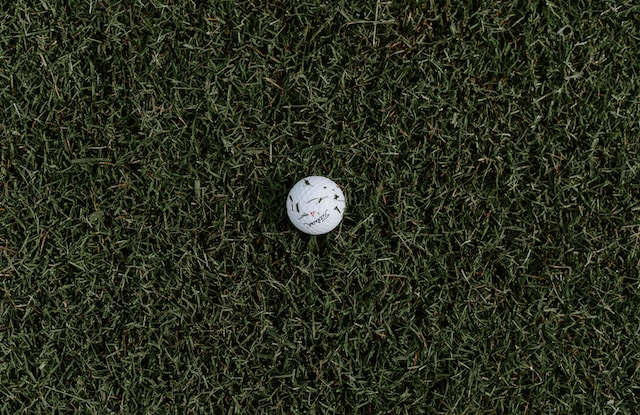Many things are important when it comes to your golf swing. However, not many are as easy to fix as the golf ball position. It is one of the basic things you should always nail down if you want a consistent golf swing. I can’t even tell you how many recreational golfers I have seen who don’t place the ball accordingly. Its proper setup will help you both execute the shot you want and play better.
Golfers tend to focus a lot on their stance and swing technique. That is perfectly fine, but in that process, the golf ball position is often overlooked. Yet, this simple adjustment can save you from a lot of frustration. We have all been there, that is a fact. Once you get the position correct for each club in your bag, you will notice an improvement in your game. Let’s go…
How Ball Position Impacts Your Shots
Trajectory
- Front Foot: Placing the ball towards your front foot generally results in a higher ball trajectory. That happens because you are hitting the ball on the upswing.
- Middle: This is a neutral position, offering a balanced trajectory.
- Back Foot: When the ball is near your trailing foot, you’ll likely hit the ball with a descending blow. That causes a lower trajectory.
Direction and Shape of Shot
The ball’s position can also influence whether you hit the ball straight, to the left, or to the right.
- Front Foot: Tends to promote a rightward (for right-handed golfers) shot shape (fade or slice).
- Middle: Aids in producing straight shots.
- Back Foot: Encourages a leftward (for right-handed golfers) ball flight (draw or hook).
Strike Quality and Distance
A good ball position ensures that you make contact with the ball at the right point in your swing arc. Poor positioning can lead to mishits:
- Too Forward: You might end up topping the ball or hitting it thin.
- Too Backward: There is a risk of hitting it fat, catching too much turf before the ball.
Consistent positioning can lead to better contact. Consequently, that ensures you achieve maximum distance and control.
The Basics of Ball Position
In simple words, the ball position is where the ball is placed in relation to your feet when addressing it. No matter what you think, you should not just drop it in any random spot. Instead, it is a precise position based on the club you are using and the shot you intend to play. Here are the three primary ball positions:
Front Foot (Forward Position)
In this position, the ball is close to your leading foot. Left foot for right-handed players and vice versa.
- Advantage: This position is optimal for maximizing the upward motion of your swing. That is ideal for longer clubs like the driver, fairway woods, hybrids, or longer irons.
- Use: Often recommended for woods and the driver, which need a sweeping motion for optimal contact and trajectory.
Middle
Here, the ball is centered between your feet. It is neither too forward nor too backward.
- Advantage: It provides a balanced blend of control and power. Makes it suitable for shots that require a combination of both.
- Use: Typically ideal for mid-irons, can be used on short-irons as well as wedges. This position ensures that the ball is struck during the most potent part of the swing arc. It provides a consistent trajectory and distance.
Back Foot (Backward Position)
With the ball closer to your trailing foot, this position is about control. Right foot for right-handed players and vice versa.
- Advantage: Helps in achieving a steeper angle of attack, allowing for more spin and control. That is especially beneficial on shots where you need the ball to stop quickly on the green.
- Use: Short irons and wedges benefit most from this position. The more downward strike imparts spin, ensuring the ball doesn’t roll too far after landing.

Finding Your Ideal Ball Position
While the above serves as a general guideline, it is essential to remember that golf is an individual sport. Thus, the ideal ball position might vary from player to player. Here is a simple method to find your perfect spot:
- Start Neutral: Begin with the ball in the middle of your stance.
- Experiment: Adjust slightly forward or backward and take note of the results. Does the shot feel more comfortable? Are the results more consistent?
- Fine-tune: Once you have a feel for your preferred position, make minor adjustments to refine further.

Tips for Consistency
- Alignment Rods: Using alignment rods or clubs on the ground can help ensure you are positioning the ball consistently during practice.
- Practice with Purpose: Don’t just mindlessly hit balls at the range. Make a conscious effort to focus on the ball position.
- Routine: Develop a pre-shot routine. Consistency in setup leads to consistency in shots.
The Power of Ball Position
Again, I can’t underestimate the importance of a correct ball position. As simple as it sounds, it carries a lot of consequences if done wrongly. You might need some time to make adjustments, but your golf game will thank you in the end. Next time you go to the driving range, pay attention to where you place the ball for each club. This will tell you a lot about your current game.
However, feel free to adjust the ball position to what suits your game. If you are playing in certain conditions, like wind, more often, then you will want to adjust to that. In the same way, you can adjust to the receptiveness of fairways and greens. You might need a shot with a higher trajectory or with a lower trajectory. Also, you might want to add spin or take spin off your ball. A lot of outside factors will come into play.
The bottom line is, to be aware of your ball position. It can make or break your round of golf, literally. The power of the ball position should never be underestimated. So, work it out during your next practice session and enjoy golfing more than ever.
What kind of shots do you prefer? Where do you mostly position your golf ball? Comment below!
Related
- How to Control Golf Ball Flight Trajectory – Best Practices
- How to Get Backspin on a Golf Ball – All You Need to Know

